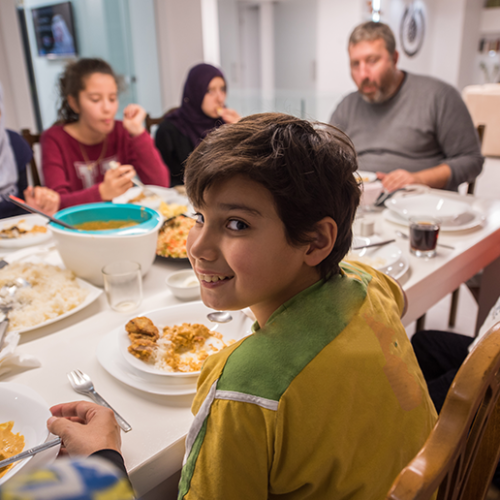Helping children overcome fear
Fear or worry are appropriate emotions for children to feel when faced with real-world dangers. They are useful in certain circumstances as they will keep your child out of harm’s way.
However, we all remember being afraid of things as a child that don’t scare us at all now. It’s common and understandable for kids to feel fear in situations that we, as adults, find harmless. Just because they aren’t a big deal to us doesn’t mean that they won’t be overwhelming to children. The best approach is not to force your child to face their fears right away but instead to encourage them to chat about how they feel and to listen to what they have to say.

As your child grows and changes, their fears will change too. Less rational fears such as being afraid of the dark or monsters in the wardrobe may be replaced by fear of strangers or injuring themselves. So, take their feelings seriously, allow them to talk about their worries, and encourage them to confront their fears in their own time. It’s so important for your child to know that you believe them and support them.
BEHIND THE FEAR
Every child is unique and some feel more fear than others. There can be several reasons for this. Overprotective parenting can result in a child who feels lost or helpless without their parents around. Having an anxious parent can teach a child that worry or anxiety is an appropriate reaction to any kind of stressful situation. Experiencing a trauma, such as an injury, can increase the general level of anxiety that a child feels. The sensitivity of children can even vary due to their personality type.
Babies and fear
From a very young age, babies form strong bonds with their parents and those who take care of them. They prefer to spend time with this ‘inner circle’ and may be afraid of anyone else. Becoming separated from their parents, even if it’s just while mum is getting the groceries, can be very upsetting as they can feel like they have been abandoned. Babies will grow out of this but it’s helpful to know the dos and don’ts of supporting them through this fearful period. Lots of babies don’t trust that a parent will return after they leave a room. This trust can be built by communicating with them when you are leaving and greeting them when you come back. This will teach your baby that they needn’t worry if you leave their sight for a moment and will encourage them that you will always return.
It’s essential that you are consistent with this, so they don’t feel that their trust has been broken. If possible, take your baby around the house with you if you have tasks to do, making sure to talk to them and include them. This helps them feel safe and valued. When introducing your baby to strangers, do so while still holding them in the safety of your arms. This embrace will keep them calm and show them that they’re not alone when faced with meeting a new person. Lastly, try not to leave your baby to cry in the hope that they will stop. It’s much better to address the anxiety they feel by consoling and soothing them in a calm and loving manner.
Toddlers and fear
It’s normal for toddlers to struggle to come to terms with feeling strong emotions. They can often get overwhelmed and scared when faced with big feelings. As they become more aware of their surroundings, they may develop irrational fears such as falling down small holes or into cracks in the pavement.
We, as adults, know that there is no real danger here but it’s important to understand that this isn’t as obvious to children. We should encourage them to express their worries and accept that the fear they feel is real. Help them overcome these fears slowly and gently, and try not to force them to face their fear immediately.
Children and fear
As your child continues to grow, their fears tend to mature with them. Their fears will usually consist of a combination of seemingly rational and irrational things. These could range from fear of abandonment or of someone breaking into the home to fear of ghosts or strangers. As always, make it clear to your child that you believe them and are taking their emotions seriously. Conversation is a great tool for helping your little one to feel less afraid. You can encourage them that you’re not going to abandon them, that nobody is going to break into the house because you’ve locked all the doors, and that they are safe.
Allow them to ask questions and give honest but calming answers. Routines are a great way to introduce stability into your child’s life. Similarly, consistent behaviour from parents, such as returning home at the time you said and not breaking promises can really help to build trust with your child and ease their worries. As they get older, it can be good for children to face their fears but it must be done at their own pace.

FEAR OF THE DARK
Being afraid of the dark is something that nearly all children experience. As mentioned, children struggle to tell the difference between what’s real and what isn’t, due to their overwhelming emotions and imaginations. They can also fear things that they don’t understand. It’s these factors that contribute to a fear of the dark (and any monsters that might be hiding there!). Without help, your child may not grow out of their fear of the dark and it could make bedtime much more difficult.
It’s particularly important to be gentle and compassionate when dealing with your child’s fear of the dark. Any display of frustration or lack of understanding around this issue can upset your child and confuse them, making the fear harder to overcome. It’s much more helpful to accept that the fear is real for them and to let them know that you will help them fight this fear. Once your child is comfortable that you believe them and they are happy to talk to you about their fear of the dark, encourage them to chat about it and what specifically they are afraid of. Be sure to put your little one at ease by gently explaining to them that monsters don’t exist and that they are totally safe.
Lots of parents will open the wardrobe and look under the bed to prove that the monsters aren’t there but this can be misunderstood by children. It may seem to them from this display that monsters do exist but they’re just not hiding in the room at that moment. That’s not very reassuring! In some cases, fear of the dark is not about anything paranormal and more related to strangers breaking into the house. It can help to show your child the locks and any other security features in the house that make it very difficult for a person to break in.
Your child may have ideas of what would make them feel safer, such as a specific teddy bear or blanket. Taking the time to ask them what they think would help will make them feel included, valued and safe.
PROFESSIONAL HELP
In more acute situations, children can be so affected by their fears that they aren’t able to interact with others or play freely. In these cases, it can be worth seeking professional help. A child psychologist will teach your child to unpack and manage their fears and anxieties and greatly improve their quality of life and can also teach parents techniques to assist their child during this time.
Your child’s fears and anxieties can arise from all kinds of experiences in different parts of their lives. Helping them to reduce their stress levels, making sure they’re only exposed to age-appropriate books and videos, establishing good habits and routines, and forming open lines of communication will all lead your child to overcoming their fears in a healthy way.












Comments